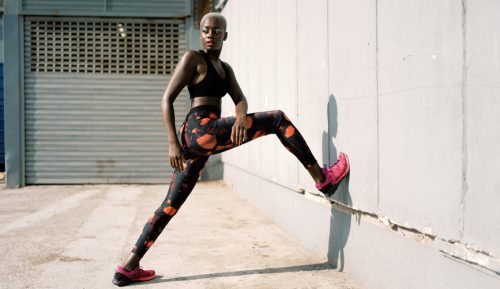Our editors independently select these products. Making a purchase through our links may earn Well+Good a commission
The 3 Easy Stretches That Everyone With Tight Achilles Tendons Should Do, According to a Physical Therapist
Tight Achilles tendons are undoubtedly painful. Thankfully, physical therapists say certain Achilles tendon stretches can help.

As the weather warms up and we’re lured outside, it’s tempting to start doing… a lot more activity than we’d been up to all winter. And whether you’re a runner, avid hiker, or walker, quickly ramping up can often lead to a super tight Achilles tendon. This large, thick band of connective tissue in the back of the ankle attaches the calf muscle group to the heel bone—and it doesn’t typically respond well to overuse.
Experts in This Article
Dr. Rashi Anand, DPT, is a certified physical therapist through CityPT and Grit ATX in Austin, Texas.
Improper footwear or biomechanics, weak calf muscles, certain medications or health conditions like diabetes and even nutritional deficiencies can also play a role in causing tightness and issues with the Achilles tendon, says Rashi Anand, DPT, a physical therapist at Grit ATX in Austin, Texas.
“We also know that the amount of rest and recovery a person includes in their training program plays a key role in their susceptibility to Achilles tightness,” says Dr. Anand.
The good news: Stretching your Achilles can help you maintain an optimal range of motion and potentially prevent discomfort.
How do you know if you have a tight Achilles tendon?
Although in some cases, it is quite obvious that your Achilles tendon is tight, in mild cases, tightness might be harder to identify. And if you have chronic Achilles tightness in both legs, you may have become so accustomed to the feeling that it’s difficult to detect.
Dr. Anand says that signs can include a limited range of motion in the ankle joint when the toes are pointing towards the knees, along with tenderness along the tendon. “Other potential symptoms could include pain, weakness in the calf muscles, and crackling or popping sensations,” she shares. It might be uncomfortable to walk or run. “Counterintuitively, some people may experience increased stiffness with inactivity, but feel better with activity, only to have the symptoms return after,” she says.
3 effective stretches for the Achilles tendon
Classic calf stretch
With this move, you should feel a stretch in your gastrocnemius (the larger calf muscle) and Achilles tendon of the back leg. Dr. Anand suggests that you can adjust the distance of your back foot from the wall to increase or decrease the intensity.
Here are the steps:
- 1.Find a wall and stand facing it with your feet hip-width apart.
- 2.Take a step back with one foot and plant the ball of that foot on the ground. Make sure to keep the toes of your feet pointing straight ahead. (Turning your foot outward reduces the stretch on the Achilles.)
- 3.Lean forward while keeping your back leg straight, and slowly shift your weight towards the wall. Keep your hips squared to the wall.
- 4.Hold the stretch for about 20 to 30 seconds.
Here’s the stretch in action:
Soleus calf stretch
The soleus is the thinner, flatter muscle that lies underneath the gastrocnemius in the calves; it tapers down and fuses into the Achilles tendon. Dr. Anand says that the soleus calf stretch is similar to the regular calf stretch, but the main difference is how you position the knee in the back leg.
“In the classic calf stretch, you keep the knee of the back leg straight, which really targets the larger calf muscle. But in the soleus calf stretch, you bend the back knee somewhat,” she says.
Here are the steps:
- 1.With your feet hip-width apart, take a step back with one foot and plant the ball of that foot on the ground.
- 2.With a slight bend in your back knee, and slowly shift your weight forward.
- 3.Hold the stretch for about 20 to 30 seconds.
Check out the stretch below:
Calf stretch in a long sitting position
If you’re looking for a gentler alternative to standing calf stretches, Dr. Anand suggests trying a calf stretch while sitting on a bed or the floor with your legs extended straight out in front of you.
Here are the steps:
- 1.Sit down with your legs extended out in front of you. You can place a rolled-up towel or yoga block under your ankles to get a deeper stretch.
- 2.Loop a belt, strap, or band around the balls of your feet and gently pull it toward you. Make sure to keep your toes pointing up.
- 3.You can also choose to stretch one leg at a time if sitting in this position is uncomfortable for you.
Check out the video below for a demonstration:
Psst: Need a resistance band? We love Popflex’s Booty Bands—this BIPOC-owned brand makes them out of fabric instead of rubber, so they won’t tug on your skin or lose their stretch over time.

Popflex Booty Bands, Set of 3 — $32.00
Before you begin any of these Achilles tendon stretches, Dr. Anand suggests applying heat (via a heating pad, warm bath, or shower) to your lower legs and feet. You can even stretch in the shower if you have enough room. “Not only does the heat feel great, but it [also] promotes blood flow and softens the Achilles and surrounding tissue for more effective stretching,” she explains.
How often should you stretch the Achilles tendon?
Dr. Anand recommends doing these three stretches three times through for one “set,” holding each for three long slow breaths each (at least 20 seconds total). Repeat that three times per day.
“Just think: ‘3x3x3’ at breakfast, lunch, and dinner,” she says. Consistency is key: Stretching frequently is an important factor in reducing stiffness and improving mobility. “Doing frequent mild to moderate stretches also promotes blood flow and circulation, which directly improves healing rate and tissue health,” she adds.
Although it may seem like a big time commitment, the entire routine shouldn’t take long, and you’ll likely feel a lot more limber and comfortable, which should help reinforce your motivation to stick with it.
Sign up for the Well+Good SHOP Newsletter
Get exclusive deals on wellness, beauty, fitness, and food products that have been hand-picked by our editors.
Got it, you've been added to our email list.







